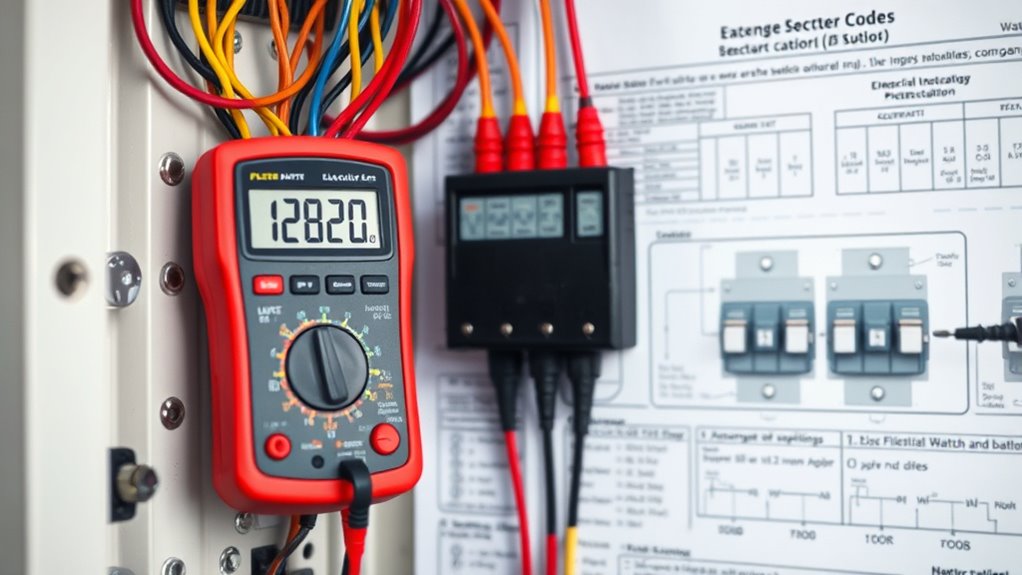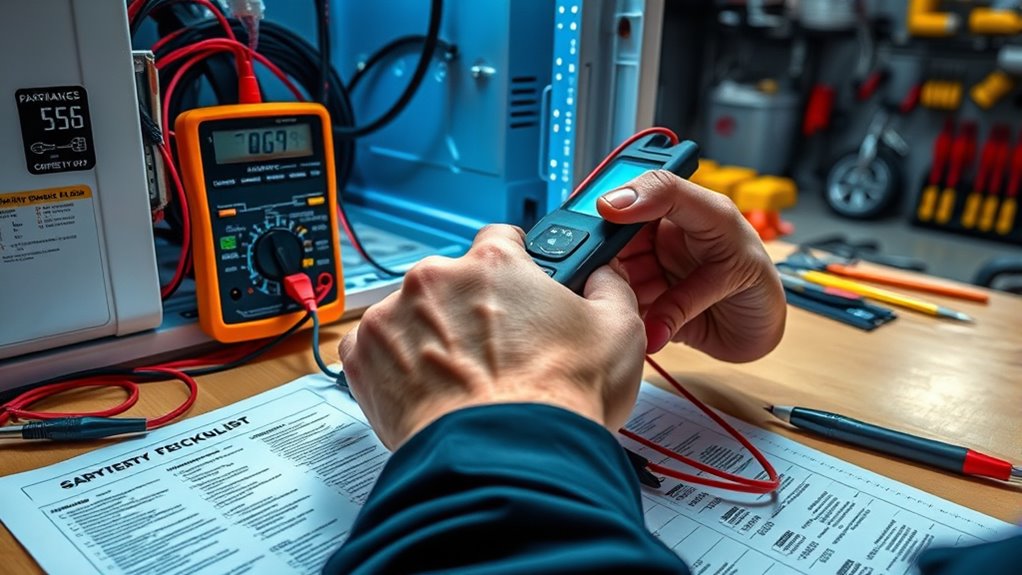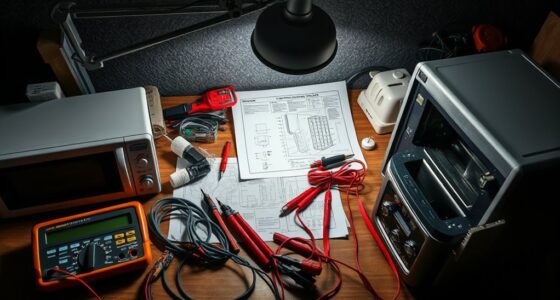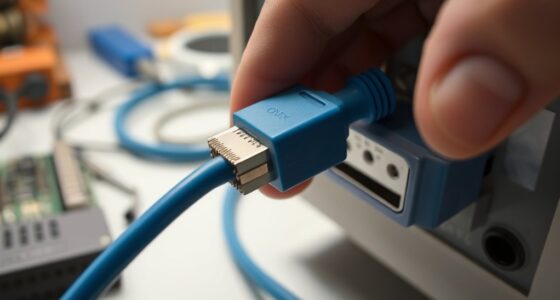Wattage planning for appliances is about more than just knowing their power ratings. While myths suggest strict wattage limits guarantee safety or longevity, what’s key is matching your wiring and circuit breakers to those ratings and following local building codes. Proper sizing prevents overloads and damage, ensuring safe, efficient operation. Understanding these factors helps you avoid unnecessary risks—continue exploring to learn how to optimize safety, compliance, and performance for your appliances.
Key Takeaways
- Building codes focus on safety and electrical capacity, not on strict wattage limits for appliance performance.
- Proper circuit and wire sizing, as per local standards, are vital for compliance and long-term appliance safety.
- Wattage alone doesn’t determine appliance longevity; correct installation, maintenance, and quality parts are more important.
- Surge protection and regular safety device checks help prevent electrical hazards and extend appliance lifespan.
- Balancing performance, safety, and energy efficiency requires understanding code requirements and appropriate electrical planning.
Understanding Appliance Wattage and Power Ratings

To understand appliance wattage and power ratings, it’s important to recognize that wattage indicates how much energy an appliance uses when it’s operating. Higher wattage often means more power, but it doesn’t always equate to better performance. Knowing an appliance’s wattage helps you assess its energy efficiency—lower wattage with the same output can save energy and reduce costs. Additionally, power ratings influence appliance durability; appliances designed for specific wattages tend to last longer and perform reliably. When selecting appliances, consider both wattage and efficiency to ensure you’re not overloading circuits or wasting energy. Understanding these ratings helps you make smarter choices, balancing performance with longevity and energy consumption for a well-planned, efficient setup. Proper appliance wattage also ensures compatibility with your home’s electrical system and compliance with safety codes.
Common Myths About Wattage Limits and Performance

Many people believe that sticking strictly to wattage limits guarantees ideal appliance performance, but this isn’t always the case. Relying solely on wattage to judge an appliance’s energy efficiency can be misleading, as other factors like design and technology play a role. Overestimating wattage restrictions may cause you to choose less effective models, impacting energy efficiency and overall performance. Additionally, some assume that staying well below wattage limits will extend an appliance’s lifespan, but this isn’t always true. Proper use, maintenance, and quality parts are more influential for longevity. Misunderstanding these myths can lead to subpar performance and unnecessary limitations, emphasizing the importance of focusing on proven performance factors rather than myths surrounding wattage limits. Incorporating AI-driven data analytics can help consumers make more informed decisions based on comprehensive appliance performance metrics rather than wattage alone.
How Building Codes Regulate Appliance Wattage

Building codes set specific standards for appliance wattage to guarantee safety, energy efficiency, and compatibility with electrical systems. These regulations help prevent overloads that could damage appliances or pose fire hazards, ensuring your appliances operate reliably over their lifespan. By establishing maximum wattage limits, codes support appliance longevity and reduce electrical waste. Additionally, they influence energy labeling requirements, making it easier for you to compare appliances based on efficiency and expected performance. Building codes also mandate compliance with manufacturer specifications, which helps avoid premature failure and costly repairs. Overall, these standards create a safer, more efficient environment, guiding you to select appliances that meet safety, energy, and longevity expectations while aligning with regulatory requirements. Understanding appliance wattage limits ensures you’re aware of the importance of these regulations in maintaining a sustainable and safe home.
The Importance of Proper Circuit and Breaker Sizing

Choosing the right circuit and breaker size helps prevent overloads and keeps your system running safely. If you underestimate the needed capacity, you risk tripping breakers or causing damage. Proper sizing provides a safety margin to protect your appliances and wiring. Additionally, considering the home theater projector specifications and power requirements can ensure optimal performance and longevity of your entertainment setup.
Avoiding Overloaded Circuits
To prevent circuit overloads, it’s essential to make certain that your wiring and breakers are properly sized for the appliances you plan to run. Proper circuit and breaker sizing helps manage your total plug load, avoiding excessive demand on any single circuit. Overloaded circuits can cause frequent breaker trips, reduce energy efficiency, and pose safety hazards. By accurately evaluating your appliance wattage and ensuring your wiring can handle the total load, you maintain a safe, reliable electrical system. Remember, oversized breakers won’t protect your wiring, while undersized ones can trip unnecessarily. Prioritizing proper sizing supports energy efficiency, reducing waste and preventing overheating. Additionally, understanding home electrical systems is crucial for making informed decisions about circuit capacity and safety. Ultimately, it’s about balancing your electrical needs with safety and efficiency, ensuring your appliances operate smoothly without risking overloads.
Ensuring Safety Margins
Ensuring safety margins in your electrical system means properly sizing your circuits and breakers to handle more than your typical load. This prevents overloads, reduces the risk of tripped breakers, and promotes consistent energy consumption. Proper sizing also extends your appliance lifespan by avoiding frequent electrical stress. To achieve this, consider: 1. Selecting circuit breakers rated 125% of the circuit’s continuous load to accommodate peak energy demands. 2. Incorporating wiring and breaker capacities that exceed average usage, accounting for future appliance additions. 3. Regularly inspecting and maintaining your system to make certain safety margins remain intact as energy consumption patterns evolve. Additionally, understanding sound healing science can help you appreciate how proper electrical safety supports overall well-being in your living space.
Balancing Safety, Efficiency, and Functionality in Wattage Planning

Balancing safety, efficiency, and functionality in wattage planning requires careful consideration of each factor’s impact on your electrical system and appliances. You want to verify your wiring can handle the load without risking safety, while also optimizing energy efficiency to reduce costs. Striking this balance means choosing wattages that meet your appliances’ needs without overloading circuits or wasting power. User convenience is key—selecting the right wattage ensures your appliances operate effectively and reliably. Keep in mind that higher wattages may boost performance but can compromise safety and efficiency if not properly managed. Ultimately, thoughtful wattage planning helps you create a safe, energy-efficient home that delivers the functionality you require without unnecessary risk or expense.
Practical Tips for Compliant and Safe Appliance Installation

To guarantee your appliances are installed safely and comply with regulations, you need to follow proper wiring practices. Using the correct circuit protection helps prevent overloads and potential hazards. Pay attention to these key points to keep your setup both safe and efficient.
Proper Wiring Practices
Proper wiring is essential for safe and compliant appliance installation, preventing electrical hazards and ensuring reliable operation. To achieve this, focus on key practices:
- Select the correct wire gauge for your appliance’s wattage, preventing overheating and potential fires.
- Ensure outlet placement aligns with the appliance’s power needs, minimizing extension cord use and overload risks.
- Use proper connectors and secure connections to maintain circuit integrity and prevent arcing.
- Be aware that understanding the appropriate wiring standards and local code requirements is crucial for compliance and safety.
Always verify that the wiring matches local code requirements, and avoid shortcuts that could compromise safety. Proper wire gauge choices and strategic outlet placement are fundamental to a safe, efficient setup. By following these practices, you ensure your appliance operates reliably while maintaining compliance.
Correct Circuit Protection
Ensuring your appliance has the right circuit protection is essential for safety and compliance. Proper circuit protection prevents overloads and electrical fires. Use the appliance labeling to determine the correct circuit breaker size and type. Installing surge protection devices adds an extra layer of safety, safeguarding your appliance from voltage spikes that can damage sensitive electronics. Always verify that the circuit breaker matches the appliance’s wattage and current requirements. Avoid using undersized or oversize breakers, as both pose risks. Regularly check and maintain surge protectors to make certain they function properly. By following these steps, you help prevent electrical hazards, ensure compliance with codes, and extend your appliance’s lifespan. Proper circuit protection is a critical component of safe, efficient appliance installation. Vetted – Mother Baby Kids
Frequently Asked Questions
How Do Local Codes Differ From National Appliance Wattage Standards?
Local codes often differ from national appliance wattage standards due to regional variations, which can lead to compliance challenges. You might find that local requirements are more stringent or adapted to specific climate or usage conditions, affecting appliance wattage limits. It’s essential to check your area’s codes early, so you can plan accordingly and avoid issues during installation or inspections. Staying informed helps guarantee your appliances meet both local and national standards.
Can Exceeding Wattage Limits Improve Appliance Performance?
Exceeding wattage limits might boost appliance performance temporarily, but it risks power surges that can damage your device and shorten its lifespan. Pushing beyond recommended wattage can cause overheating, reduce efficiency, and lead to costly repairs. Instead, stick to the specified wattage to guarantee safe operation, prevent power surges, and extend your appliance’s lifespan. Proper planning and compliance protect both your investment and your safety.
What Are the Penalties for Non-Compliance With Wattage Regulations?
Like steering through a maze, if you disregard wattage regulations, you risk penalties fines during a wattage inspection. Authorities enforce strict compliance, and non-compliance can lead to costly fines, delays, or even appliance shutdowns. Staying within wattage limits ensures safety and smooth operation, avoiding these penalties. Always monitor your appliance wattage, follow codes, and consult professionals to keep your setup compliant and avoid unnecessary trouble.
How Does Wattage Planning Affect Energy Efficiency Incentives?
Wattage planning directly impacts your energy savings and eligibility for incentive programs. By choosing appliances with ideal wattage, you can reduce energy consumption, lowering costs and boosting your chances of qualifying for incentives aimed at energy efficiency. Properly planning wattage ensures you meet program requirements while maximizing savings. Staying informed about wattage standards helps you leverage incentives effectively, making your energy-efficient upgrades more affordable and sustainable.
Are There New Technologies Influencing Wattage Regulations Recently?
Yes, new technologies like smart appliances and renewable integration are influencing wattage regulations recently. Smart appliances optimize energy use, often requiring less wattage, which helps meet evolving standards. Renewable integration encourages lower wattage consumption to maximize efficiency and support sustainable energy sources. These advancements push regulators to update wattage regulations, ensuring appliances are compatible with modern energy systems and promote smarter, greener energy consumption.
Conclusion
Guiding wattage planning is like tending a delicate garden—you must balance safety, efficiency, and performance to let your appliances flourish. By understanding the truths behind myths and following building codes, you create a sturdy foundation for your home’s electrical health. Think of proper circuit sizing as the guiding sun, nurturing your system without scorching it. With informed choices, you’ll keep your electrical landscape thriving, vibrant, and resilient against the storms of misuse and misunderstanding.









